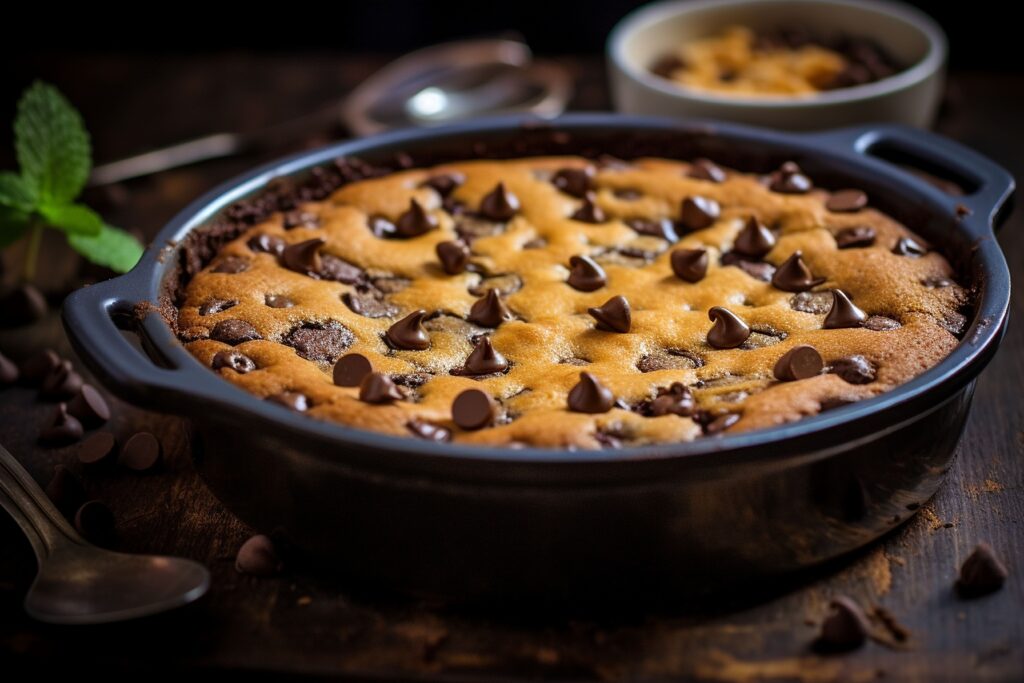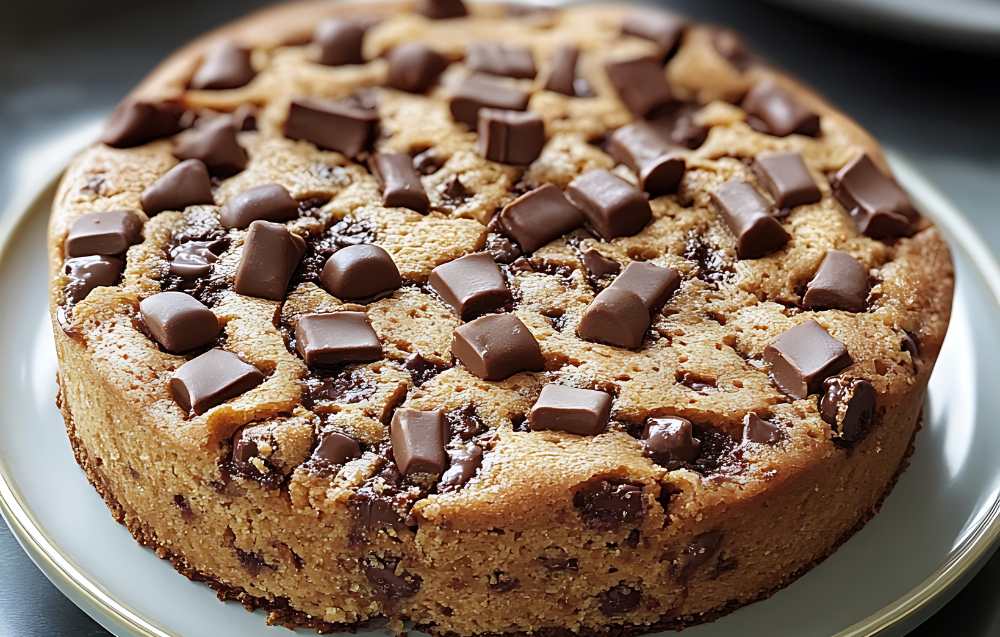When it comes to baking a cookie cake, the pan you choose can make or break your dessert masterpiece. But don’t sweat it—I’m here to guide you through the ins and outs of picking the perfect pan. Whether you’re aiming for a crispy edge, gooey center, or something in between, the right pan is the secret ingredient to success. Ready to dive into the delicious world of cookie cakes? Let’s get started!
Introduction to Baking the Perfect Cookie Cake
Let’s be honest—cookie cakes are the best of both worlds. You get the chewy, buttery goodness of cookies with the grandeur of a cake. But baking a cookie cake is not as straightforward as throwing dough into any pan you have lying around. Choosing the right pan is where the magic happens. Why? Because it directly affects the texture, shape, and even how evenly your cookie cake bakes.

Think of the pan as your baking buddy—it needs to complement your recipe, not work against it. So, let’s uncover why this choice is so crucial.
If you’re looking to expand your cookie cake repertoire, check out this guide on how to make a cookie cake. It offers a comprehensive step-by-step process for crafting a flawless cookie cake.
Why Choosing the Right Pan Matters
If you’ve ever wondered why some cookie cakes turn out as dreamy as Pinterest photos while others fall flat (literally), the pan might be the culprit. Let’s break it down.
Impact on Texture and Consistency
Think of your pan as the foundation of your cookie cake. The right pan can give you crispy edges and a soft, chewy middle, while the wrong one might leave you with a dessert that’s either too dry or too gooey. If you’re a fan of experimenting with unique textures and flavors, try the tips and tricks shared in cookie cake bliss for inspiration.
“A good pan is like a good pair of shoes—it supports the entire performance.”
Baking Evenness and Heat Distribution
Heat distribution is key for achieving that picture-perfect bake. Ever notice how some cookie cakes have uneven patches of color? That’s the result of a pan that doesn’t conduct heat evenly. The material and thickness of your pan make a huge difference in how your cookie cake bakes. Choosing wisely here can mean the difference between dessert bliss and dessert disaster.
Types of Pans for Baking Cookie Cakes
Now, let’s get to the fun part—exploring your options! Each type of pan brings something unique to the table. Here’s a breakdown of the most popular choices:
Traditional Round Cake Pans
This classic option is a go-to for many bakers. Round cake pans are versatile and create a nice, even shape for your cookie cake. They’re ideal for recipes that require precise baking times since their sturdy build ensures even heat distribution.
Cast Iron Skillets
Cast iron skillets? For a cookie cake? You bet! They’re perfect for creating a rustic, crispy edge while keeping the center delightfully gooey. Plus, they’re naturally nonstick and retain heat well, so your cookie cake stays warm and yummy longer.
Glass Baking Dishes
Glass pans are great for seeing how your cookie cake is browning on the bottom. They’re a little slower to heat up but retain heat well once they’re hot. Just be careful not to overbake—glass can get very hot and hold onto that heat, which might dry out your cake.
Nonstick Metal Pans
Nonstick pans are a baker’s dream because, well, nothing sticks! They’re great for easy cleanup and produce a golden-brown crust. Just make sure you use silicone utensils to avoid scratching the nonstick coating.
Silicone Baking Molds
Silicone molds are a newer option, and they’re gaining popularity for their flexibility and ease of use. You can pop the cookie cake right out without worrying about it breaking. However, they don’t conduct heat as well as metal pans, so your bake might take a little longer.
Comparing Pan Materials
Not all pans are created equal, and the material they’re made from can make a world of difference. Let’s take a closer look.
Aluminum vs. Stainless Steel
Aluminum pans are lightweight and conduct heat quickly, making them a popular choice for evenly baked cookie cakes. Stainless steel, on the other hand, is sturdier but doesn’t conduct heat as efficiently. If you’re aiming for a foolproof bake, aluminum might be your best bet.
Cast Iron vs. Nonstick
Cast iron skillets add a rustic charm and excel at retaining heat, while nonstick pans make cleanup a breeze. Both are excellent choices, but it depends on your preference—do you want crispy edges (cast iron) or a smoother, low-maintenance bake (nonstick)?
Glass vs. Silicone
Glass pans are great for monitoring your bake, while silicone molds are practically mess-proof. However, silicone’s flexibility can sometimes mean uneven bakes, so it’s not ideal if you’re a perfectionist.
Common Problems When Choosing a Pan
Even experienced bakers encounter a few bumps in the road when choosing a pan. Let’s address some common pitfalls and how to avoid them.
Enhancing Your Cookie Cake Experience
If you’re passionate about creating unique desserts, pairing the right pan with creative recipes is essential. You might also want to explore how other cookie trends, like those highlighted in Crumbl Cookies: The Weekly Flavor Adventure You’ll Love, can inspire your next cookie cake masterpiece.
Uneven Baking or Burnt Edges
This often happens with pans that don’t distribute heat evenly. Thinner pans or those made from cheap materials are usually the culprits. Opt for a high-quality metal pan or cast iron to prevent this issue.
Cookie Cake Sticking to the Pan
There’s nothing more heartbreaking than a cookie cake that won’t budge from the pan. Nonstick pans or prepping your pan with parchment paper are lifesavers here. Trust me—prevention is key!
“A well-prepped pan is like insurance for your cookie cake—it ensures things don’t fall apart.”
Wrong Size or Shape of Pan
Using a pan that’s too small can lead to overflowing, while one that’s too big might leave you with a thin, overcooked cake. Always match your recipe to the size of the pan for best results.
Solutions and Pro Tips
Baking the perfect cookie cake doesn’t have to be a trial-and-error experience. With a few simple tips and tricks, you can dodge the most common problems and ensure your dessert turns out just the way you want it. Let’s dive into some solutions and pro tips for nailing your cookie cake every single time.
Prepping Your Pan Correctly
Preparing your pan is one of the simplest ways to guarantee success. A little effort upfront can save you from a sticky situation later on.
- Grease and Line: Always start by greasing your pan with butter or nonstick spray. Then, add a layer of parchment paper for extra insurance. This simple step makes removal a breeze. If you’re new to this method, check out how to prevent cookie sticking to learn why parchment paper is a baker’s best friend.
- Match the Pan to the Recipe: Every recipe has its ideal pan size and type. Follow these guidelines closely to avoid issues like uneven baking or overflow.
Adjusting for Pan Materials
Not all pans are created equal. The material your pan is made from can significantly impact the texture and consistency of your cookie cake. For a deeper dive into how different materials work, explore this bakeware material guide.
Cast Iron Skillets: Retain heat like a pro, creating rustic, chewy edges.
Metal Pans: Heat quickly and are great for crispy edges.
Glass Pans: Heat slowly but retain warmth, ideal for gooey centers.
“Parchment paper is like a superhero cape for your pan—it saves the day, every time!”
Ensuring Even Baking
Have you ever baked a cookie cake only to find parts overcooked and others underdone? Uneven baking can be frustrating, but it’s easily fixed with the right strategies.
- Rotate your pan halfway through baking to ensure all sides cook evenly.
- Use an oven thermometer to verify the correct temperature since many ovens have uneven heat zones. For additional insights on achieving consistent results, check this guide on the science of baking evenly.
- If you’re working with a thin dough, consider using an aluminum pan, which distributes heat quickly and uniformly.
“Even baking isn’t just about the pan—it’s about understanding how heat flows and how your oven works.”
Recommendations for Specific Scenarios
Not all cookie cakes are created equal, and sometimes, your occasion calls for a specific kind of bake. Whether you’re whipping up a giant dessert for a party or aiming for an Instagram-worthy presentation, here are some tailored recommendations.
Best Pan for Large Cookie Cakes
Hosting a crowd? Go for a rectangular baking pan or even a pizza pan. These pans allow you to spread the dough evenly for a large, shareable dessert. Just make sure the pan is sturdy enough to handle the weight of a giant cookie cake without warping in the oven.
Ideal Pan for Thick and Gooey Cookie Cakes
For that thick, gooey goodness, a cast iron skillet is your best friend. The pan’s heavy-duty material retains heat beautifully, baking the edges to crispy perfection while keeping the center soft and melt-in-your-mouth delicious.
Best Option for Decorative Presentations
If you want your cookie cake to be as pretty as it is tasty, consider a springform pan or a shaped silicone mold. These options make it easy to release the cake cleanly, giving you a smooth canvas to decorate with frosting, sprinkles, or other fun toppings.
Caring for and Maintaining Your Baking Pans
Investing in the right pan is only half the battle—you also need to take care of it. Proper maintenance can extend the life of your pans and ensure consistent baking results every time.
Cleaning Nonstick and Silicone Pans
Cleaning your pans correctly is key. For nonstick pans, avoid abrasive scrubbers that can damage the coating. Use a soft sponge and warm, soapy water instead. Silicone molds are even easier—most are dishwasher-safe, so you can simply toss them in and let the machine do the work.
Tips for Extending Pan Longevity
- Avoid Drastic Temperature Changes: Never submerge a hot pan in cold water—this can cause warping or cracks.
- Store Properly: Stack pans with a layer of parchment paper in between to prevent scratches.
- Use the Right Tools: Opt for silicone or wooden utensils when working with nonstick pans to avoid damage.
Taking care of your pans might seem like a chore, but trust me, it’s worth it. A well-maintained pan is like a trusty sidekick—it’ll always have your back.
“Treat your pans well, and they’ll reward you with perfectly baked treats for years to come.”
Frequently Asked Questions About Cookie Cake Pans
Still have some lingering doubts? Let’s clear up some of the most common questions bakers have about cookie cake pans.
Can I Use a Regular Cake Pan for Cookie Cakes?
Absolutely! A regular round cake pan works perfectly for most cookie cake recipes. Just make sure it’s the right size for your dough, and don’t forget to grease and line it.
Are Cast Iron Pans Safe for Baking?
Yes, cast iron pans are not only safe but also fantastic for baking. They create a beautifully crispy edge and keep your cookie cake warm for longer. Just remember to season your cast iron regularly to maintain its nonstick properties.
What’s the Easiest Pan to Clean?
Silicone pans win the cleanup game hands down. They’re flexible, nonstick, and often dishwasher-safe. However, if you prefer metal pans, a nonstick coating combined with parchment paper can make cleaning just as effortless.
Conclusion: Baking the Perfect Cookie Cake
By now, you should feel like a cookie cake pan expert! From understanding how different pans affect texture to learning how to care for them, you’re equipped with all the tips and tricks you need to bake like a pro. Remember, the right pan can transform your cookie cake from ordinary to extraordinary. So, go ahead—grab your favorite pan, whip up some dough, and let the baking adventure begin!
Mastering the Art of Cookie Cake Baking: Final Tips and Takeaways
Let’s wrap things up by diving into some final insights, advanced techniques, and creative ideas to elevate your cookie cake game. By this point, you know how to pick the perfect pan, avoid common pitfalls, and maintain your tools. Now, let’s focus on the details that can turn a good cookie cake into a great one.
Elevating Your Cookie Cake: Pro-Level Tips
So, you’ve got the basics down, but what about taking things up a notch? Here are some advanced tips for baking cookie cakes that will wow your taste buds (and anyone else lucky enough to get a slice).
Adjusting Baking Time for Different Pan Types
Different pans require different baking times. For example:
- Glass pans tend to hold heat longer, so you may need to reduce your oven temperature slightly and bake for a few extra minutes.
- Cast iron skillets heat up quickly, which can result in crispy edges sooner than expected. Keep an eye on your bake and reduce the time if needed.
- Silicone molds may require a bit more time because they don’t conduct heat as efficiently as metal pans.
Always keep a close watch during the last few minutes of baking—cookie cakes can go from golden brown to overdone in no time.
Experimenting with Dough Thickness
Do you like a thick, hearty cookie cake or a thinner, crispier version? Your pan choice and how you spread the dough can make all the difference. For a thicker cake, use a smaller pan or double up your recipe. For a thinner cake, spread the dough evenly in a larger pan, keeping the edges slightly thicker to prevent burning.
Creative Ideas to Customize Your Cookie Cake
Cookie cakes are versatile and provide the perfect canvas for your culinary creativity. Here are a few ways to personalize your dessert:
Add Toppings Before Baking
Sprinkle your favorite toppings onto the dough before it hits the oven. Ideas include:
- Chocolate chips or chunks for an extra indulgent layer of chocolate.
- Chopped nuts like pecans, walnuts, or almonds for a nutty crunch.
- Colorful candies like M&Ms or sprinkles for a festive touch.
Layer the Dough
Why settle for just one flavor? Try layering different cookie doughs in the same pan. For example, use a layer of classic chocolate chip dough as the base and top it with a peanut butter cookie dough layer. When baked, the layers create a visually stunning and delicious dessert.
Use Frosting and Decorations
After your cookie cake has cooled, take it up a notch with frosting. Use a piping bag to create intricate designs, or keep it simple with a layer of creamy frosting spread evenly over the top. Add decorations like:
- Crushed cookies for extra texture.
- Drizzles of chocolate or caramel for a decadent finish.
- Seasonal decorations like Halloween candy or Christmas sprinkles to fit the occasion.
“Think of your cookie cake as a blank canvas—your imagination is the only limit!”
Troubleshooting Last-Minute Baking Issues
Even seasoned bakers run into problems from time to time. Here’s how to handle some common last-minute challenges:
The Cookie Cake Is Too Dry
If your cookie cake turns out dry, don’t panic. This can happen if you overbake or if your pan conducts heat too intensely. To salvage it:
- Brush the surface with simple syrup (a mix of water and sugar) to add moisture.
- Serve it with a scoop of ice cream or a dollop of whipped cream to mask any dryness.
The Edges Are Overcooked
Overcooked edges are a common issue, especially with metal or cast iron pans. To prevent this:
- Wrap the edges of your pan with aluminum foil mid-bake to slow down cooking.
- Use an oven thermometer to ensure your oven isn’t running hotter than the set temperature.
If it’s too late and the edges are already overcooked, you can trim them off and disguise the cake with frosting or whipped cream.
The Cake Won’t Release from the Pan
A stuck cookie cake can feel like a disaster, but there’s hope:
- Place the pan on a warm, damp towel for a few minutes. The steam can help loosen the cake.
- Run a knife gently around the edges to release it.
- If all else fails, serve it directly from the pan—it’ll still taste amazing!
Serving and Storing Your Cookie Cake
Once your masterpiece is out of the oven, you’ll want to ensure it stays as delicious as the moment it was baked. Here’s how:
Serving Tips
- For clean slices, use a sharp knife dipped in warm water and wiped clean between cuts.
- Pair your cookie cake with a scoop of ice cream, a drizzle of chocolate syrup, or a dollop of whipped cream for an extra treat.
Storing Your Cookie Cake
- Room Temperature: Wrap it tightly in plastic wrap or store it in an airtight container to keep it fresh for up to three days.
- Refrigeration: If you’ve frosted the cake, store it in the fridge. Just bring it back to room temperature before serving for the best flavor.
- Freezing: Cookie cakes freeze beautifully! Wrap them tightly in plastic wrap and aluminum foil, then freeze for up to three months. Thaw at room temperature before serving.
Final Thoughts: Bake with Confidence
Baking a cookie cake is as much about the journey as it is about the final product. With the right pan, a little preparation, and some creativity, you can whip up a dessert that’s guaranteed to impress. Remember, baking is an art and a science—don’t be afraid to experiment and make the recipe your own.
“The perfect cookie cake isn’t about perfection—it’s about creating something delicious and memorable.”
Now, grab your favorite pan, preheat that oven, and let the baking magic begin. Your perfect cookie cake awaits!

